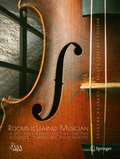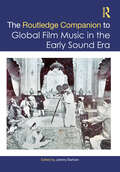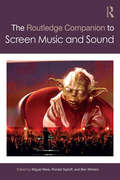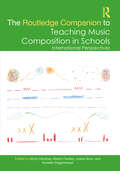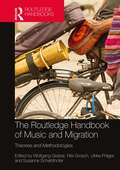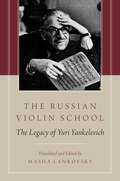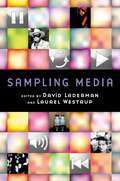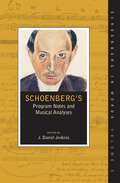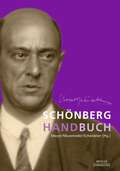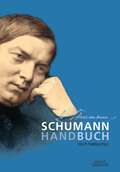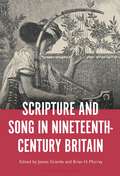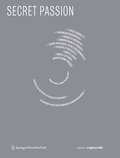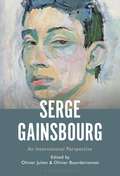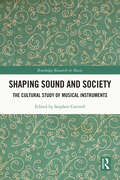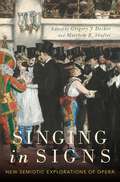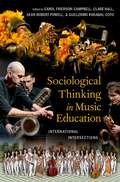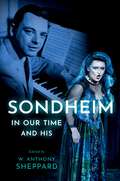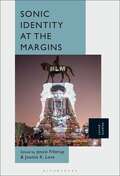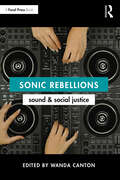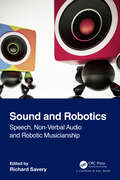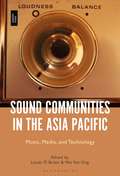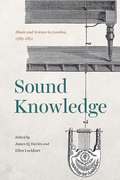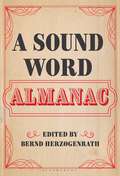- Table View
- List View
Rooms for the Learned Musician: A 20-Year Retrospective on the Acoustics of Music Education Facilities
This beautifully illustrated volume takes the reader on a wide-ranging tour through music education facilities designed during the past 20 years, with a particular emphasis on the acoustical and architectural design of the locations. The book opens with a series of essays from key design team members, including an acoustical consultant, architect, audio/video systems consultant, and theatre consultant. The main body of the work consists of a rich array of contributions from acoustical consulting firms and music education facility designers from across the world on their recent innovative works in the area of music education facility acoustics. Each entry includes high-resolution photos and renderings, scientific data, and evocative descriptions of the music education facilities. Filled with beautiful photography and fascinating modern design, this book is a must-read for anyone interested in music education architecture, acoustical design, or musical performance. “This new publication on design of music education facilities is highly welcomed. Not only does it present many acoustically interesting projects, it also gives an up-to-date introduction to the scientific knowledge and design practice in this field. The book also helps the reader to understand why it is so important to ensure good acoustic conditions in music education facilities: to nourish students at all levels to achieve their goals as musicians.” - Anders Chr. Gade, Ph.D., senior consultant at Gade & Mortensen Akustik and author of Acoustics in Halls for Speech and Music (chapter in Springer Handbook of Acoustics) “This book ensures the reader will see the full vocabulary of elemental solutions to broad challenges. The expected concert halls, rehearsal spaces, and practice rooms are joined by newer, essential components: recording studios, control rooms, vocal booths, beat labs, and more. This media-rich publication enables detailed study while motivating big picture, interdisciplinary thinking. This new book curates and beautifully structures a deep store of outstanding architectural achievements that are sure to kindle the creation of future successful music education facilities.” - Alex U. Case, Associate Professor of Sound Recording Technology at the University of Massachusetts Lowell and author of Sound FX – Unlocking the Creative Potential of Recording Studio Effects “This book is a wonderful collection of music education facilities. The narratives and images provide a wealth of information for the casual reader, student in acoustics, architect, owner/educator, and acoustician. Primary schools through universities are not often studied and reviewed. Finding a thorough collection of these space types is rare. This book is recommended for anyone who is studying, designing, or enjoys reading about music education facilities.” - Jason Duty, P.E., Vice President at Charles M. Salter Associates, Inc.
The Routledge Companion to Global Film Music in the Early Sound Era (Routledge Music Companions)
In a major expansion of the conversation on music and film history, The Routledge Companion to Global Film Music in the Early Sound Era draws together a wide-ranging collection of scholarship on music in global cinema during the transition from silent to sound films (the late 1920s to the 1940s). Moving beyond the traditional focus on Hollywood, this Companion considers the vast range of cinema and music created in often-overlooked regions throughout the rest of the world, providing crucial global context to film music history. An extensive editorial Introduction and 50 chapters from an array of international experts connect the music and sound of these films to regional and transnational issues—culturally, historically, and aesthetically—across five parts: Western Europe and Scandinavia Central and Eastern Europe North Africa, The Middle East, Asia, and Australasia Latin America Soviet Russia Filling a major gap in the literature, The Routledge Companion to Global Film Music in the Early Sound Era offers an essential reference for scholars of music, film studies, and cultural history.
The Routledge Companion to Screen Music and Sound (Routledge Music Companions)
The Routledge Companion to Screen Music and Sound provides a detailed and comprehensive overview of screen music and sound studies, addressing the ways in which music and sound interact with forms of narrative media such as television, videogames, and film. The inclusive framework of "screen music and sound" allows readers to explore the intersections and connections between various types of media and music and sound, reflecting the current state of scholarship and the future of the field. A diverse range of international scholars have contributed an impressive set of forty-six chapters that move from foundational knowledge to cutting edge topics that highlight new key areas. The companion is thematically organized into five cohesive areas of study: Issues in the Study of Screen Music and Sound—discusses the essential topics of the discipline Historical Approaches—examines periods of historical change or transition Production and Process—focuses on issues of collaboration, institutional politics, and the impact of technology and industrial practices Cultural and Aesthetic Perspectives—contextualizes an aesthetic approach within a wider framework of cultural knowledge Analyses and Methodologies—explores potential methodologies for interrogating screen music and sound Covering a wide range of topic areas drawn from musicology, sound studies, and media studies, The Routledge Companion to Screen Music and Sound provides researchers and students with an effective overview of music’s role in narrative media, as well as new methodological and aesthetic insights.
The Routledge Companion to Teaching Music Composition in Schools: International Perspectives (Routledge Music Companions)
The Routledge Companion to Teaching Music Composition in Schools: International Perspectives offers a comprehensive overview of teaching composing from a wide range of countries around the world. Addressing the current state of composition pedagogy from primary to secondary school levels and beyond, the volume explores issues, including different curricular and extracurricular settings, cultural aspects of composing, aesthetics, musical creativity, the role of technology, and assessment. With contributors from over 30 countries, this volume encompasses theoretical, historical, empirical, and practical approaches and enables comparisons across different countries and regions. Chapters by experienced educators, composers, and researchers describe in depth the practices taking place in different international locations. Interspersed with these chapters, interludes by the volume editors contextualize and problematize the teaching and learning of composing music. The volume covers a range of contexts, including formal and informal, those where a national curriculum is mandated or where composing is a matter of choice, and a range of types, styles, and genres of musical learning and music-making. Providing a wide-ranging and detailed review of international approaches to incorporating music composition in teaching and learning, this volume will be a useful resource for teachers, music education researchers, graduate and undergraduate students, and all those working with children and young people in composing music.
The Routledge Handbook of Music and Migration: Theories and Methodologies (Routledge Music Handbooks)
The Routledge Handbook of Music and Migration: Theories and Methodologies is a progressive, transdisciplinary paradigm-shifting core text for music and migration studies. Conceptualized as a comprehensive methodological and theoretical guide, it foregrounds the mobile potentials of music and presents key arguments about why musical expressions matter in the discussion of migration politics. 24 international specialists in music and migration set methodological and theoretical standards for transdisciplinary collaborations in the field of migration studies, discussing 41 keywords, such as mobility, community, research ethics, human rights, and critical whiteness in the context of music and migration. The authors then apply these terms to 16 chapters, which deal with ethnomusicological, musicological, sociological, anthropological, geographical, pedagogical, political, economic, and media-related methodologies and theories which reflect and contest current discourses of migration. In their interdisciplinary focus, these chapters advance interrelations between music and migration as enabling factors for socio-cultural studies. Furthermore, the authors tackle crucial questions of agency, equality, and equity as well as the responsibilities and expectations of writers and artists when researching migration phenomena as innate human experience. As a result, this handbook provides scholars and students alike with relevant and applicable methodological and theoretical tools in addition to an extensive literature and research review for further research.
The Russian Violin School: The Legacy of Yuri Yankelevich
The Russian school of violin playing produced many of the twentieth century's leading violinists - from the famed disciples of Leopold Auer such as Jascha Heifetz, Nathan Milstein, and Mischa Elman to masters of the Soviet years such as David Oistrakh and Leonid Kogan. Though descendants of this school of playing are found today in every major orchestra and university, little is known about the pedagogical traditions of the Russian, and later Soviet, violin school. Following the revolution of 1917, the center of Russian violin playing and teaching shifted from St. Petersburg to Moscow, where violinists such as Lev Tseitlin, Konstantin Mostras, and Abraham Yampolsky established an influential pedagogical tradition. Founded on principles of scientific inquiry and physiology, this tradition became known as the Soviet Violin School, a component of the larger Russian Violin School. Yuri Yankelevich (1909 - 1973), a student and assistant of Abraham Yampolsky, was greatly influenced by the teachers of the Soviet School and in turn he became one of the most important pedagogues of his generation. Yankelevich taught at the Moscow Conservatory from 1936 to 1973 and produced a remarkable array of superb violinists, including forty prizewinners in international competitions. Extremely interested in the methodology of violin playing and teaching, Yankelevich contributed significant texts to the pedagogical literature. Despite its importance, Yankelevich's scholarly work has been little known outside of Russia. This book includes two original texts by Yankelevich: his essay on positioning the hands and arms and his extensive research into every detail of shifting positions. Additional essays and commentaries by those close to him examine further details of his pedagogy, including tone production, intonation, vibrato, fingerings and bowings, and his general approach to methodology and selecting repertoire. An invaluable resource for any professional violinist, Yankelevich's work reveals an extremely sophisticated approach to understanding the interconnectivity of all components in playing the violin and is complete with detailed practical suggestions and broad historical context.
Sampling Media
This book puts sampling studies on the academic map by focusing on sampling as a logic of exchange between audio-visual media. While some recent scholarship has addressed sampling primarily in relation to copyright, this book is a first: a critical study of sampling and remixing across audio-visual media. Of special interest here are works that bring together both audio and visual sampling: music that samples film and television; underground dance and multimedia scenes that rely on sampling; Internet "memes" that repurpose music videos, trailers and news broadcasts; films and videos that incorporate a wide range of sampling aesthetics; and other provocative variations. Comprised of four sections titled "roots," "scenes," "cinema" and "web" this collection digs deep into and across sampling practices that intervene in popular culture from unconventional or subversive perspectives. To this end, Sampling Media extends the conceptual boundaries of sampling by emphasizing its inter-medial dimensions, exploring the politics of sampling practice beyond copyright law, and examining its more marginal applications. It likewise puts into conversation compelling instances of sampling from a wide variety of historical and contemporary, global and local contexts.
Schoenberg's Program Notes and Musical Analyses (Schoenberg in Words)
In 1950, as Arnold Schoenberg anticipated the publication of a collection of 15 of his most important writings, Style and Idea, he was already at work on a second volume to be called Program Notes. Inspired by this idea, Schoenberg's Program Notes and Musical Analyses can boast the most comprehensive study of the composer's writings about his own music yet published. Schoenberg's insights emerge not only in traditional program notes, but also in letters, sketch materials, pre-concert talks, public lectures, contributions to scholarly journals, newspaper articles, interviews, pedagogical materials, and publicity fliers. The editions of the texts in this collection, based almost exclusively on Schoenberg's original manuscript sources, include many items appearing in print in English for the first time, as well as more familiar texts that preserve musical and textual information eliminated from previous editions. The book also reveals how Schoenberg, desirous to communicate with and educate an audience, took every advantage of changes in technology during his lifetime, utilizing print media, radio broadcasts, record jackets--and had he lived, television--for this purpose. In addition to four chapters in which Schoenberg illuminates 42 of his own compositions, the book begins with chapters on his development and influences, his thoughts about trends in modern music, and, in a nod to the importance of the radio in providing a venue for music analysis, a chapter about Schoenberg's radio broadcasts.
Schönberg-Handbuch
Arnold Schönberg war als Komponist und Künstlerpersönlichkeit gleichermaßen einflussreich und umstritten. Seine musikalischen Werke, seine Unterrichtstätigkeit und sein theoretisches Werk begründeten die „Neue Musik“ des 20. Jahrhunderts, seine Schriften – von der tagesaktuellen Polemik bis zur theologischen Reflexion – spiegeln die intellektuelle Entwicklung einer ganzen Epoche, seine bis heute kontrovers beurteilte Malerei ist ein faszinierender Nebenpfad des österreichischen Expressionismus. Zum 150. Geburtstag erscheint eine umfassende Bestandsaufnahme dieses Jahrhundertwerks – mit aktuellen Forschungsergebnissen, analytischen und essayistischen Beiträgen, ausführlicher Chronik und Werkregistern. Schönbergs „Lebenswelten“ – mit Schauplätzen u.a. in Wien, Berlin und Los Angeles – bieten den Hintergrund detaillierter Einzelbesprechungen der Kompositionen – von Verklärte Nacht bis zu Ein Überlebender aus Warschau. Im systematischen Durchgang kommen – neben den Schriften und bildnerischen Werken – grundlegende Fragen der musikalischen Poetik oder der Aufführungslehre zur Sprache. Ein eigener Hauptabschnitt gilt der epochalen Wirkung dieses Œuvres: von den Anfängen der Wiener Schule bis zur aktuellen Rezeption im 21. Jahrhundert.
Schönberg-Handbuch
Arnold Schönberg war als Komponist und Künstlerpersönlichkeit gleichermaßen einflussreich und umstritten. Seine musikalischen Werke, seine Unterrichtstätigkeit und sein theoretisches Werk begründeten die „Neue Musik“ des 20. Jahrhunderts, seine Schriften – von der tagesaktuellen Polemik bis zur theologischen Reflexion – spiegeln die intellektuelle Entwicklung einer ganzen Epoche, seine bis heute kontrovers beurteilte Malerei ist ein faszinierender Nebenpfad des österreichischen Expressionismus. Zum 150. Geburtstag erscheint eine umfassende Bestandsaufnahme dieses Jahrhundertwerks – mit aktuellen Forschungsergebnissen, analytischen und essayistischen Beiträgen, ausführlicher Chronik und Werkregistern. Schönbergs „Lebenswelten“ – mit Schauplätzen u.a. in Wien, Berlin und Los Angeles – bieten den Hintergrund detaillierter Einzelbesprechungen der Kompositionen – von Verklärte Nacht bis zu Ein Überlebender aus Warschau. Im systematischen Durchgang kommen – neben denSchriften und bildnerischen Werken – grundlegende Fragen der musikalischen Poetik oder der Aufführungslehre zur Sprache. Ein eigener Hauptabschnitt gilt der epochalen Wirkung dieses Œuvres: von den Anfängen der Wiener Schule bis zur aktuellen Rezeption im 21. Jahrhundert.
Schumann-Handbuch
Seine Musik hat ihn unsterblich gemacht. Doch wer war Robert Schumann? Als Komponisten und Virtuosen, Dichter und Journalisten, Freund und Ehemann lernt der Leser ihn kennen und findet Zugang zu seiner Literatur-, Musik- und Kunstanschauung. Im Mittelpunkt stehen Schumanns kompositorisches Lebenswerk und seine Kompositionsweise. Geordnet nach Gattungen liefert das Handbuch einen umfangreichen Überblick über sein gesamtes Werk. Schumanns Schaffen spiegelt sich auch in der Musik anderer Komponisten wider. In welchen Werken erkennt man seinen Einfluss? Wie haben Musikgeschichtsschreibung, Belletristik und Film Schumann gewürdigt? Die namhaften Autoren zeichnen ein neues, spannendes Bild.
Scripture and Song in Nineteenth-Century Britain
This volume brings together new approaches to music history to reveal the interdependence of music and religion in nineteenth-century culture. As composers and performers drew inspiration from the Bible and new historical sciences called into question the historicity of Scripture, controversies raged over the performance, publication and censorship of old and new musical forms. From oratorio to opera, from parlour song to pantomime, and from hymn to broadside, nineteenth-century Britons continually encountered elements of the biblical past in song. Both elite and popular music came to play a significant role in the formation, regulation and contestation of religious and cultural identity and were used to address questions of class, nation and race, leading to the beginnings of ethnomusicology. This richly interdisciplinary volume brings together musicologists, historians, literary and art historians and theologians to reveal points of intersection between music, religion and cultural history.
Secret Passion: Künstler und ihre Musik-Leidenschaften / Artists and their musical desires (Edition Angewandte)
CM VON HAUSSWOLFF: Ist hier irgendwer, der mit dieser Musik Coca-Cola-Flaschen v- kaufen würde? EDEK BARTZ: Naja,warten wir’s ab.Man weiß nie.Die Zeiten ändern sich.Ganz herzlichen Dank für diese Einführung in die elektronische Musik,dafür,dass du uns all ihre Gehe- nisse verraten hast. Es war wirklich interessant. (Zum Publikum gewandt) Wenn es euch interessiert: Die Bibliothek besitzt auch eine Serie von CDs mit elektronischer Musik,die ihr hier anhören könnt, und eine sehr in- ressante Geschichte der elektronischen Musik.Ich empfehle auch wärmstens vier CDs über das,was uns Carl Michael heute über die Anfänge der elektronischen Musik erzählt hat,von den allerersten Geräten bis heute. Es gibt in der Bibliothek auch Kataloge von verschiedenen Ausstellungen, die sich mit diesem Sound beschäftigt haben. Die kann man anschauen und ausleihen. Lasst mich nun Carl Michael nochmals dafür danken, dass er heute hier bei uns war, und für das wundervolle Gespräch.Vielen Dank. 131 SECRET PASSION 5 CARL MICHAEL VON HAUSSWOLFF 13 132 2 CARL MICHAEL VON HAUSSWOLFF talks to EDEK BARTZ about electronic music… EDEK BARTZ: I would like to begin by briefly explaining our format. Our series is not s- posed to be a major educational project; we do not want to go the academic way. On the contrary it should be enjoyable–a talk about the passion of the invited artists, about their passion for music. I never know beforehand what they are going to play.
Serge Gainsbourg: An International Perspective
Serge Gainsbourg is arguably the Francophone songwriter whose contribution to the international appeal of French popular music has been the most significant in the post-war era. Sampled by Beck, De La Soul, Massive Attack and Fatboy Slim, remixed by Howie B. and David Holmes, translated by Mick Harvey, and covered by Iggy Pop, Donna Summer, Portishead, Madeleine Peyroux, the Pet Shop Boys and Franz Ferdinand, his music has crossed borders in a way no other modern French-language singer-songwriter's has.The interdisciplinary approach of Serge Gainsbourg: An International Perspective engages in a dialogue between musicology, film and media studies, literature, cultural studies, gender studies, and more, revealing the broad scope of Gainsbourg's impact in and outside of France, from the late 1950s through today. Bringing together a large selection of scholars from across the world, this collection of 26 chapters emphasizes his unique position in French culture, covering issues such as his musical influences and collaborations, esthetics and form, his experimentations with disciplines other than music (mainly film and literature), not to mention the conversation at play between high art and mass culture in this artist's multifaceted body of work.
Shaping Sound and Society: The Cultural Study of Musical Instruments (Routledge Research in Music)
This volume brings together leading voices from the new wave of research on musical instruments to consider how we can connect the material aspects of instruments with their social function, approaches that have been otherwise too frequently separated in musical scholarship. Shaping Sound and Society: The Cultural Study of Musical Instruments locates the instruments at the centre of cultural interactions. With contributions from ten scholars spanning a variety of methodologies and a wide range of both contemporary and historic music cultures, the volume is divided into three sections. Contributors discuss the relationships between makers, performers, and their local communities; the different meanings that instruments accrue as they travel over time and place; and the manner in which instruments throw new light on historic music cultures. Alongside the scholarly chapters, the volume also includes a selection of shorter interludes based on interviews with makers of comparatively new instruments, offering further insights into the process of musical instrument innovation. An essential read for students and academics in the fields of music and ethnomusicology, this volume will also interest anyone looking to understand how the cultural interaction of musical instruments is deeply informed and influenced by social, technological, and cultural change.
Singing in Signs: New Semiotic Explorations of Opera
Singing in Signs: New Semiotic Explorations of Opera offers a bold and refreshing assessment of the state of opera study as seen through the lens of semiotics. At its core, the volume responds to Carolyn Abbate and Roger Parker's Analyzing Opera, utilizing a semiotic framework to embrace opera on its own terms and engage all of its constituent elements in interpretation. Chapters in this collection resurrect the larger sense of serious operatic study as a multi-faceted, interpretive discipline, no longer in isolation. Contributors pay particular attention to the musical, dramatic, cultural, and performative in opera and how these modes can create an intertext that informs interpretation. Combining traditional and emerging methodologies, Singing in Signs engages composer-constructed and work-specific music-semiotic systems, broader socio-cultural music codes, and narrative strategies, with implications for performance and staging practices today.
Sociological Thinking in Music Education: International Intersections
Sociological Thinking in Music Education presents new ideas about music teaching and learning as important social, political, economic, ecological, and cultural ways of being. At the book's heart is the intersection between theory and practice where readers gain glimpses of intriguing social phenomena as lived through music learning and teaching. The vital roles played by music and music education in various societies around the world are illustrated through pivotal intersections between music education and sociology: community, schooling, and issues of decolonization. In this book, emerging as well as established scholars mobilize the links between applied sociology, music, education, and music education in ways that intersect the scholarly and the personal. These interdisciplinary vantage points fulfil the book's overarching aim to move beyond mere descriptions of what is, by analyzing how social inequalities and inequities, conflict and control, and power can be understood in and through music teaching and learning at both individual and collective levels. The result is not only encountering new ideas regarding the social construction of music education practices in specific places, but also seeing and hearing familiar ones in fresh ways. Digital assets enable readers to meet the authors and the points of their inquiry via various audiovisual media, including videos, a documentary music film, and multi-lingual video précis for each chapter in English as well as in each author's language of origin.
Sondheim in Our Time and His
Sondheim in Our Time and His offers a wide-ranging historical investigation of the landmark works and extraordinary career of Stephen Sondheim, a career which has spanned much of the history of American musical theater. Each author uncovers those aspects of biography, collaborative process, and contemporary context that impacted the creation and reception of Sondheim's musicals. In addition, several authors explore in detail how Sondheim's shows have been dramatically revised and adapted over time. Multiple chapters invite the reader to rethink Sondheim's works from a distinctly contemporary critical perspective and to consider how these musicals are being reenvisioned today. Through chapters focused on individual musicals, and others that explore a specific topic as manifested throughout his entire career, plus an afterword by Kristen Anderson-Lopez; by digging deep into the archives and focusing intently on his scores; from interviews with performers, directors, and bookwriters, and close study of live and recorded productions--volume editor W. Anthony Sheppard brings together Sondheim's past with the present, thriving existence of his musicals.
The Songs of Fanny Hensel
Fanny Hensel created some of the most imaginative and original music of her era, making her arguably the most gifted female composer of the nineteenth century. While Hensel has finally stepped out of the shadow of her famous brother, Felix Mendelssohn, as scholars have begun to study her life and writings, her music has remained surprisingly underexamined. This collection places Hensel's music at the center, focusing on the genre that not only made up more than half of her creative output but also, as Hensel herself put it, "suits her best": song. In eleven new essays, leading scholars in the fields of music theory and musicology consider Hensel's songs from a wide range of angles, covering topics such as Hensel's fascination with particular poets and poetic themes; her innovative harmonic, melodic, rhythmic, and textual strategies; and her connection to larger literary and musical trends. The chapters also provide insight into Hensel's efforts to break free from the constraints placed on her as a woman and her place in the larger history of the nineteenth-century Lied. Drawing on diverse biographical, historical, cultural, and musical contexts for their detailed discussions of Hensel's songs, the authors underline Hensel's historical importance and deepen our understanding and appreciation of her compositions. This volume, in short, finally gives Fanny Hensel and her songs the stage that they deserve.
Sonic Identity at the Margins
Sonic Identity at the Margins convenes the interdisciplinary work of 17 academics, composers, and performers to examine sonic identity from the 19th century to the present. Recognizing the myriad aspects of identity formation, the authors in this volume adopt methodological approaches that range from personal accounts and embodied expression to archival research and hermeneutic interpretation. They examine real and imagined spaces-from video games and monument sites to films and depictions of outer space-by focusing on sonic creation, performance, and reception. Drawing broadly from artistic and performance disciplines, the authors reimagine the roles played by music and sound in constructing notions of identity in a broad array of musical experiences, from anti-slavery songsters to Indigenous tunes and soundscapes, noise and multimedia to popular music and symphonic works. Exploring relationships between sound and various markers of identity-including race, gender, ability, and nationality-the authors explore challenging, timely topics, including the legacies of slavery, indigeneity, immigration, and colonial expansion. In heeding recent calls to decolonize music studies and confront its hegemonic methods, the authors interrogate privileged perspectives embedded in creating, performing, and listening to sound, as well as the approaches used to analyze these experiences.
Sonic Rebellions: Sound and Social Justice
Sonic Rebellions combines theory and practice to consider contemporary uses of sound in the context of politics, philosophy, and protest, by exploring the relationship between sound and social justice, with particular attention to sonic methodologies not necessarily conceptualised or practiced in traditional understandings of activism.An edited collection written by artists, academics, and activists, many of the authors have multidimensional experiences as practitioners themselves, and readers will benefit from never-before published doctoral and community projects, and innovative, audio-based interpretations of social issues today. Chapters cover the use of soundscapes, rap, theatre, social media, protest, and song, in application to contemporary socio-political issues, such as gentrification, neoliberalism, criminalisation, democracy, and migrant rights. Sonic Rebellions looks to encourage readers to become, or consider how they are, Sonic Rebels themselves, by developing their own practices and reflections in tandem to continue the conversation as to how sound permeates our sociopolitical lives.This is an essential resource for those interested in how sound can change the world, including undergraduates and postgraduates from across the social sciences and humanities, scholars and instructors of sound studies and sound production, as well as activists, artists, and community organisers.
Sound and Robotics: Speech, Non-Verbal Audio and Robotic Musicianship
Sound in human–robot interaction currently encompasses a wide range of approaches and methodologies not easily classified, analyzed or compared among projects. This edited book covers the state of the art in sound and robotics, aiming to gather existing approaches in a combined volume. Collecting chapters from world-leading academic and industry authors, Sound and Robotics: Speech, Non-Verbal Audio and Robotic Musicianship explores how robots can communicate through speech, non-verbal audio and music. The first set of chapters explores how robots use verbal communication, considering the possibilities of speech for human–robot interaction. The second section shifts to roles of non-verbal communication in HRI, including consequential sound, sonification and audio cues. The third and final section describes current approaches to robotic musicianship and their evaluation. This book is primarily aimed at HRI researchers, ranging from those who have never used sound to those very experienced with sound. Alongside robotic researchers, this book will present avenues for a diverse range of musicians, composers and sound designers to become introduced to the world of HRI and learn of potential creative directions in robotics.
Sound Communities in the Asia Pacific: Music, Media, and Technology
The popularization of radio, television, and the Internet radically transformed musical practice in the Asia Pacific. These technologies bequeathed media broadcasters with a profound authority over the ways we engage with musical culture. Broadcasters use this power to promote distinct cultural traditions, popularize new music, and engage diverse audiences. They also deploy mediated musics as a vehicle for disseminating ideologies, educating the masses, shaping national borders, and promoting political alliances. With original contributions by leading scholars in anthropology, ethnomusicology, sound studies, and media and cultural studies, the 12 essays this book investigate the processes of broadcasting musical culture in the Asia Pacific. We shift our gaze to the mechanisms of cultural industries in eastern Asia and the Pacific islands to understand how oft-invisible producers, musicians, and technologies facilitate, frame, reproduce, and magnify the reach of local culture.
Sound Knowledge: Music and Science in London, 1789-1851
What does it mean to hear scientifically? What does it mean to see musically? This volume uncovers a new side to the long nineteenth century in London, a hidden history in which virtuosic musical entertainment and scientific discovery intersected in remarkable ways. Sound Knowledge examines how scientific truth was accrued by means of visual and aural experience, and, in turn, how musical knowledge was located in relation to empirical scientific practice. James Q. Davies and Ellen Lockhart gather work by leading scholars to explore a crucial sixty-year period, beginning with Charles Burney’s ambitious General History of Music, a four-volume study of music around the globe, and extending to the Great Exhibition of 1851, where musical instruments were assembled alongside the technologies of science and industry in the immense glass-encased collections of the Crystal Palace. Importantly, as the contributions show, both the power of science and the power of music relied on performance, spectacle, and experiment. Ultimately, this volume sets the stage for a new picture of modern disciplinarity, shining light on an era before the division of aural and visual knowledge.
A Sound Word Almanac
This almanac of sound words important to artists and scholars highlights words that expand the way we speak (and write) about sonic experiences.Why write about sound, and how? If sonic philosophy is the attempt "to think about sound by philosophical means," then a metaphilosophical debate appears almost immediately on the horizon: What is called for is an understanding about sound and language, but also about the preconditions of musical understanding. What is at stake is the question of language and sound, as well as expanding how we speak about sonic experience.This almanac tackles these questions from artistic, experimental and personal perspectives. An assemblage of nearly 70 practitioners and theoreticians, artists and scholars offer their favorite 'sound word.' These sound words are onomatopoetical, mythological, practical; words of personal importance to the artists and their craft; words from their memory, related to sound. Many entries are not in English – some are untranslatable – and all are accompanied by a personal, explanatory, poetic entry. These are words that have the potential to change our perspective on listening-musicking-thinking.
